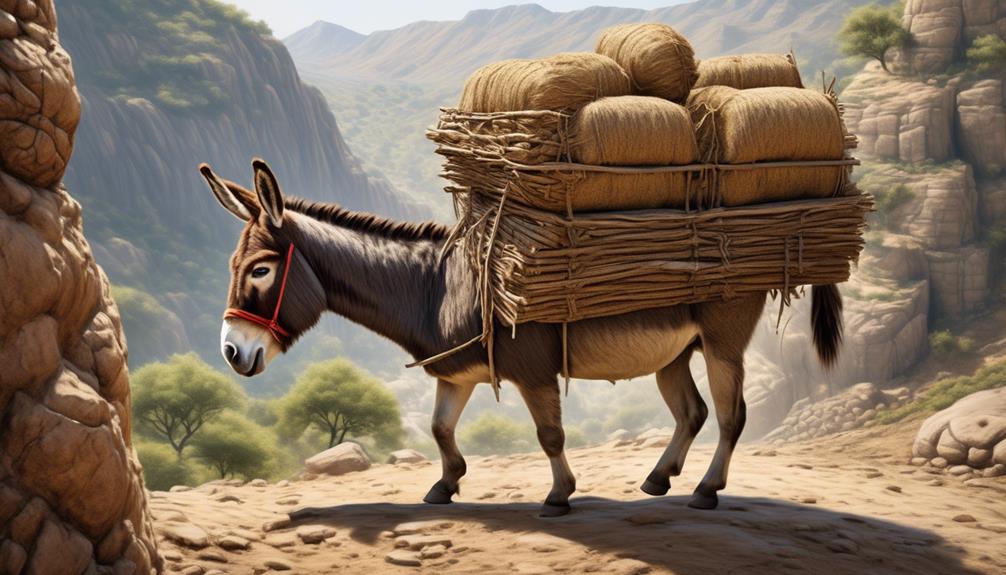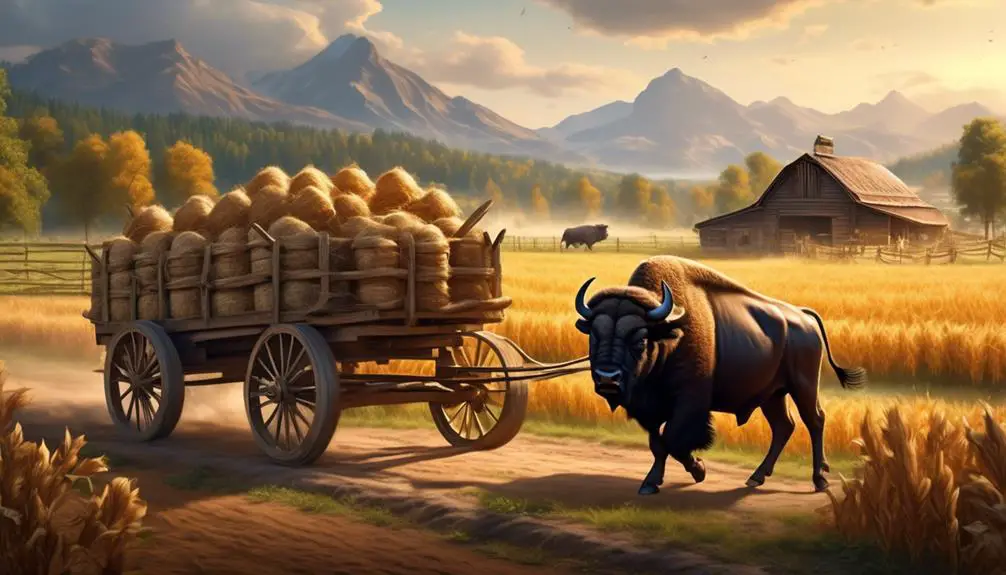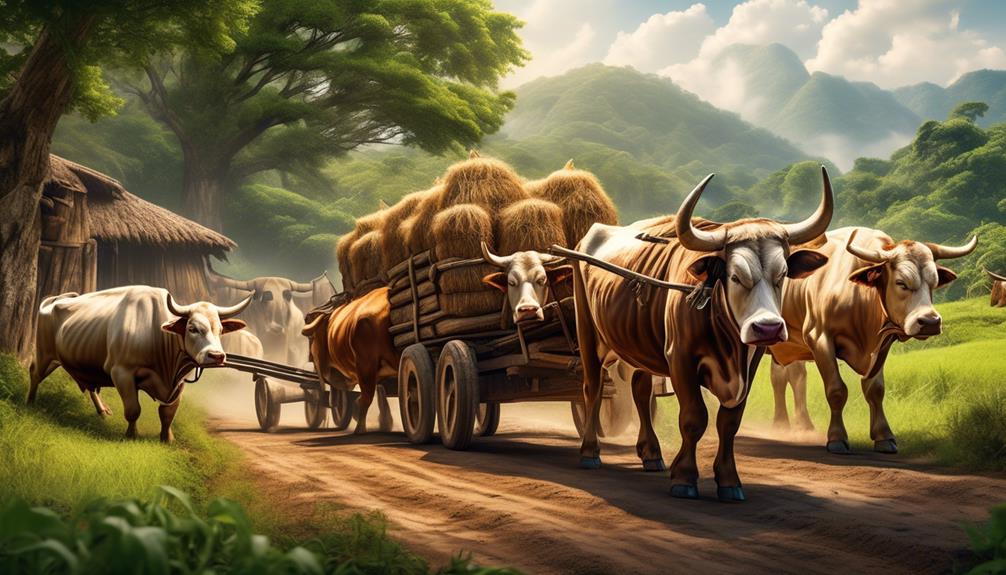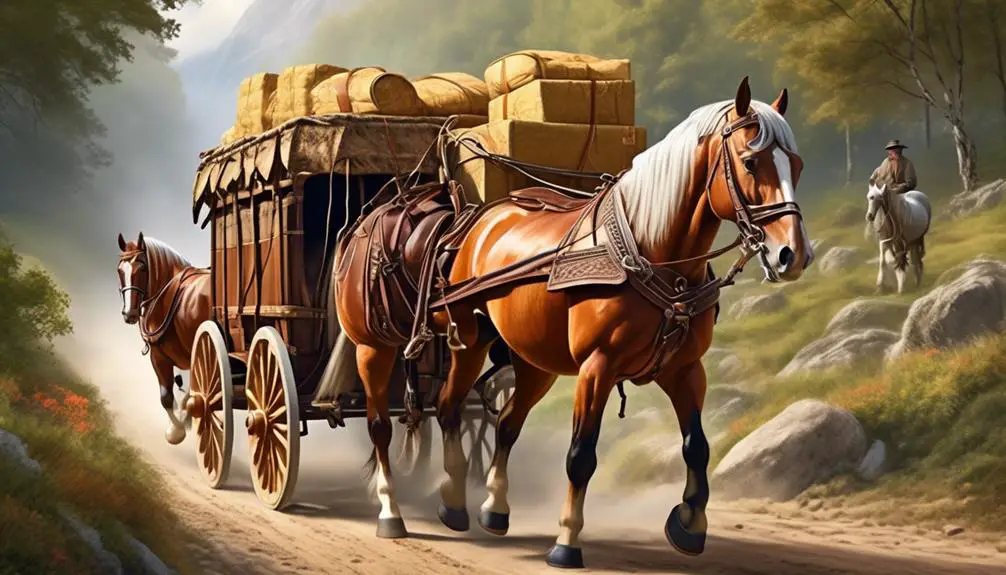Are you intrigued by the immense strength and endurance of animals that bear heavy burdens? Have you ever wondered how these incredible creatures are able to carry such loads without breaking a sweat?
Well, prepare to be amazed as we uncover the secrets behind their remarkable abilities. From the towering camels of the desert to the sturdy donkeys navigating rugged terrains, we will explore the world of animals that shoulder immense responsibilities.
But that’s not all – there are even more surprising load carriers waiting to be discovered. So, join us on this captivating journey as we unravel the fascinating stories of these remarkable creatures and the challenges they face.
Camels as Load Carriers

Camels have been utilized as efficient load carriers since the Middle Ages, due to their remarkable capacity to bear significant amounts of weight. Their ability to carry heavy loads is truly impressive. When observing camels in action, one can see how they effortlessly handle the burden placed upon them.
Camels, known as ‘ships of the desert,’ have evolved to thrive in arid regions such as North and West Africa, as well as parts of West Asia. Their ability to survive long periods without water and withstand extreme temperatures makes them well-suited for their role as load carriers in these harsh environments.
Their physical attributes, such as their strong legs and broad padded feet, enable them to traverse rough terrains with ease. Additionally, their humps, which aren’t water storage as commonly believed, actually store fat reserves to provide energy during long journeys. This unique adaptation allows camels to carry heavy loads over long distances without succumbing to exhaustion.
While camels have been invaluable in various parts of the world where no other modes of travel are available, it’s important to note that they’ve often been subjected to cruelty due to their load-carrying ability. It’s crucial that we treat these magnificent creatures with respect and ensure their well-being while benefiting from their exceptional load-bearing capabilities.
Donkeys and Their Load-Carrying Ability

Donkeys have been used for centuries to carry loads. Their load-carrying ability is quite impressive. A healthy donkey can carry up to 125 pounds of weight without injuring itself. However, several factors need to be considered to determine its maximum load capacity. These factors include the donkey’s maturity, fitness, and overall health.
Donkey Load Capacity
When considering load-carrying ability, donkeys exhibit impressive strength and endurance. They’ve been used for centuries to transport goods and supplies in various terrains. A healthy, mature donkey can carry a load weighing up to 125 pounds without injuring itself.
However, several factors need to be taken into account. The donkey’s maturity, fitness, and overall health greatly influence its load-carrying capacity. Additionally, the terrain plays a crucial role in determining the weight a donkey can comfortably carry. Donkeys are often used in rugged terrains where other modes of transportation are impractical.
Before embarking on a hike or journey, it’s essential to trim the donkey’s hooves to ensure proper traction and prevent any discomfort or injuries. Donkeys are remarkable animals with an innate ability to bear burdens, making them invaluable for transporting goods in challenging environments.
Factors Affecting Donkey’s Ability
As we explore the factors that affect a donkey’s ability to carry loads, it becomes evident that their load-carrying capacity is influenced by various key elements.
Firstly, the maturity of the donkey plays a significant role. Younger donkeys may not have fully developed muscles and skeletal structure, which can limit their ability to carry heavy loads.
Secondly, the fitness level of the donkey is crucial. A well-conditioned donkey with strong muscles and good stamina can handle heavier loads compared to a less fit donkey.
Lastly, the overall health of the donkey is essential. Any underlying health issues or injuries can affect their ability to carry loads. Regular veterinary check-ups and proper care are vital to ensure that donkeys remain healthy and capable of carrying loads efficiently.
Elephants: Unsuitable for Heavy Work

Elephants, despite their immense size and strength, are ill-suited for heavy work due to their unique spinal structure and the physical and mental toll it takes on them.
Their spinal column, although strong, isn’t designed to bear excessive weight for extended periods. The weight of heavy loads compresses the discs in their spine, leading to chronic pain and potential injuries. Additionally, elephants have a complex social structure and intricate emotional lives, making them highly sensitive creatures. The rigorous demands of heavy work, such as logging or carrying heavy equipment, can cause immense stress and anxiety for these gentle giants.
Furthermore, elephants aren’t physiologically built for the repetitive strain of heavy labor. Their long legs and broad feet are adapted for walking long distances, not for carrying excessive weight. The excessive strain on their joints and muscles can lead to debilitating conditions such as arthritis and foot problems. These conditions further decrease their ability to withstand heavy work.
Moreover, the mental toll of heavy work on elephants shouldn’t be underestimated. These intelligent beings require mental stimulation, social interactions, and freedom to roam. Confining them to monotonous and labor-intensive tasks deprives them of their natural behaviors and can lead to boredom, frustration, and even aggression.
Reindeer as Pack Animals

Reindeer, known for their association with carrying heavy loads in childhood stories of Santa Claus, serve as reliable and efficient pack animals. These majestic creatures have the ability to pull a sleigh weighing up to 140 kilograms, making them ideal for transporting goods across vast distances. Unlike other pack animals, reindeer are easy to tame and harness, making them a practical choice for carrying heavy loads.
To further understand the capabilities of reindeer as pack animals, let’s compare them to other animals commonly used for this purpose:
| Animal | Load Capacity |
|---|---|
| Camels | Significant amount of load |
| Donkeys | Up to 125 pounds without injury |
| Elephants | Unsuitable for heavy work |
| Reindeer | Can pull a sleigh weighing up to 140 kilograms |
| Buffalos | Primarily used in farming for carrying heavy loads |
| Oxen | Powerful muscles enable them to pull heavy loads |
| Horses | Can bear up to 20% of their weight |
As we can see, reindeer possess impressive strength and endurance, comparable to camels, donkeys, and oxen. Additionally, they are not expensive to raise and maintain, making them a cost-effective choice for pack animal purposes.
Buffalos in Farming and Load Carrying

Buffalos, commonly associated with carrying heavy loads in farming, play a vital role in agricultural practices and load carrying. They’re often seen in fields, harnessed to plows, tilling the land with their powerful muscles. Buffalos are well-suited for this work due to their strength and endurance. Their ability to carry heavy loads makes them an invaluable asset in farming.
In agricultural practices, buffalos are used to transport various farm produce such as hay, paddy, and vegetables. Their sturdy build allows them to carry substantial amounts of weight without difficulty. The use of buffalos in load carrying not only eases the burden on farmers but also ensures the efficient transportation of goods.
Observing buffalos in action reveals their remarkable strength and determination. They plow through the fields with a steady pace, their muscles flexing as they pull the load. Their focused gaze and steady strides demonstrate their dedication to the task at hand.
Over the years, laws have been introduced to prevent cruelty against buffalos and ensure their well-being while carrying loads. This reflects the recognition of their importance in farming and the need to treat them with respect and care.
Oxen as Draft Animals

In farming practices, oxen serve as valuable draft animals, utilizing their powerful muscles to assist in tasks such as plowing and tilling the land. Oxen have been used for centuries, and their suitability for this work is evident in their physical attributes and behavior.
These animals possess strong muscles in their shoulders and necks, which allow them to pull heavy loads with relative ease. Their large size and sturdy build make them well-suited for the demanding work of tilling the soil and preparing it for planting.
Oxen are also known for their docile and calm temperament, which makes them easier to handle compared to other draft animals like buffalos. They can maneuver easily on both soft and hard ground, making them adaptable to different terrains.
Additionally, oxen are capable of working long hours without tiring easily, making them reliable partners in the field. Their contribution to farming practices can’t be understated, as they play a crucial role in ensuring the success of agricultural endeavors.
Horses: Versatile Load Carriers

As we shift our focus to the topic of horses as versatile load carriers, we can observe their remarkable strength and adaptability in various roles and terrains. Horses have been used as farm animals for centuries, pulling carts and wagons to transport goods. They’re also relied upon in mountainous regions where other forms of transport aren’t available. In these challenging terrains, horses demonstrate their agility and surefootedness, making them invaluable companions for trekkers and mountaineers.
One of the key qualities that makes horses such effective load carriers is their ability to bear up to 20% of their own weight. This means that a well-conditioned horse can carry a substantial amount of load without compromising its own health and well-being. However, it’s important to note that proper care and management are essential to ensure the horse’s continued ability to carry weights. Regular exercise, a balanced diet, and adequate rest are crucial to maintaining the horse’s physical condition and preventing injuries.
Horses’ versatility as load carriers is further demonstrated by their use in various roles beyond transportation. They’re trained to perform tasks such as pulling plows in agricultural settings, assisting in search and rescue operations, and even participating in competitive events like rodeos and horse shows. Their strength, endurance, and willingness to work make them ideal partners in these demanding activities.
Mules: Reliable Load Bearers
Mules, with their unique combination of strength, endurance, and adaptability, have long been recognized as reliable load bearers. These remarkable animals are the offspring of a male donkey and a female horse, inheriting the best traits from both parents. Mules are known for their ability to carry heavy loads over long distances without succumbing to fatigue. Their sturdy build and surefootedness make them ideal for navigating challenging terrains such as steep mountains or rocky paths.
Let’s take a closer look at the characteristics that make mules such dependable load carriers:
| Trait | Description |
|---|---|
| Strength | Mules possess exceptional strength, derived from their donkey heritage. This enables them to bear heavy loads without strain. |
| Endurance | Mules have incredible stamina, allowing them to travel for extended periods without tiring. Their ability to conserve energy makes them ideal for long journeys. |
| Adaptability | Mules are highly adaptable creatures, capable of adjusting to varying climates and terrains. Whether it’s scorching deserts or freezing mountains, mules can endure and perform efficiently. |
| Intelligence | Mules are renowned for their intelligence, which aids them in understanding and responding to the commands of their handlers. Their ability to assess situations and make decisions enhances their reliability as load bearers. |
Llamas as Load Carriers in South America
Llamas, the sturdy and reliable load carriers of South America, possess unique characteristics that make them invaluable in transporting goods and supplies across the diverse landscapes of the region. With their strong and muscular bodies, llamas are well-equipped to bear heavy loads, making them ideal for this task.
Their long legs and padded feet enable them to navigate different terrains, whether it be the steep slopes of the Andes or the rugged trails of the Amazon rainforest.
One notable feature of llamas is their ability to carry loads without causing harm to themselves. Unlike some other animals, llamas have a natural inclination to distribute weight evenly, ensuring that the burden isn’t concentrated in one area. This reduces the risk of injury and strain on their bodies, allowing them to endure long journeys with relative ease.
Furthermore, llamas are highly adaptable animals, capable of adjusting to the changing environmental conditions of South America. They’re able to withstand high altitudes, harsh climates, and limited food resources, making them well-suited for long-distance journeys through varying landscapes.
In addition to their physical attributes, llamas also possess a calm and docile temperament, making them easy to handle and work with. Their cooperative nature allows them to be trained and guided effectively, ensuring that they can navigate challenging terrains and deliver their loads safely.
Yaks: Load Carriers in High Altitude Regions

Yaks, known for their remarkable adaptations to high altitude regions, are highly efficient load carriers in mountainous areas. Their ability to navigate steep and rugged terrain, along with their strong build and endurance, makes them invaluable for transporting heavy loads in challenging environments.
Yaks play a crucial role in supporting the livelihoods of people in these regions, providing a reliable means of transportation for goods and supplies.
Yak Adaptations for Altitude
The extraordinary adaptations of these high-altitude load carriers enable them to thrive in the challenging environments they call home.
Yaks, specifically, have evolved remarkable features that allow them to navigate the harsh conditions of high altitudes. One of their key adaptations is their thick, double-layered coat, which provides insulation against the cold temperatures. This coat consists of a soft undercoat and a coarse outer layer that helps to retain body heat and protect them from the biting winds.
Additionally, yaks have large lungs and a robust circulatory system that allows for efficient oxygen uptake, crucial at high altitudes where oxygen levels are lower.
Their strong hooves provide stability and traction on steep and rocky terrains, allowing them to carry heavy loads without stumbling.
Yak Load Capacity
Adapted to thrive in high-altitude environments, these resilient creatures possess the remarkable ability to carry heavy loads without stumbling or faltering. Yaks, native to the Himalayan region, have long been utilized as reliable pack animals by local communities. Their load capacity is truly impressive, with adult male yaks capable of carrying up to 200 kilograms and female yaks up to 120 kilograms. This table showcases the load capacity of yaks compared to other animals commonly used for carrying loads:
| Animal | Load Capacity (in kilograms) |
|---|---|
| Yaks | Male: 200, Female: 120 |
| Camels | 200 |
| Donkeys | 125 |
| Elephants | Not suitable |
| Reindeer | 140 |
As seen in the table, yaks surpass camels and donkeys in their load-carrying ability. Their sturdy build, muscular strength, and adaptability to high altitudes make them an ideal choice for transporting heavy loads in challenging terrains. It is truly fascinating to witness these magnificent creatures effortlessly navigate through treacherous mountain pathways while shouldering burdens that would be daunting for other animals.
Yak Role in Mountainous Areas
In mountainous areas, yaks play a crucial role as load carriers in high altitude regions. These majestic creatures have adapted to the harsh conditions and rugged terrain, making them well-suited for transporting heavy loads.
With their strong muscular build and sturdy hooves, yaks are able to navigate the steep slopes and rocky paths with ease. Their thick fur provides insulation against the cold temperatures, allowing them to thrive in these challenging environments.
Yaks are known for their endurance and resilience, making them ideal for carrying supplies and equipment to remote areas that are inaccessible by vehicles. Their docile nature and surefootedness make them reliable companions for mountaineers and local communities alike.
In mountainous regions, yaks are truly the backbone of transportation, enabling essential goods to reach their destinations efficiently and effectively.
Dogs: Surprising Load Carriers

Dogs, with their remarkable strength and endurance, have proven themselves to be surprisingly capable load carriers. Their ability to carry loads can be observed in various working dog breeds, such as the Alaskan Malamute and the Saint Bernard. These dogs have been bred for centuries to assist humans in transporting heavy loads in challenging environments.
When it comes to load carrying, dogs possess several distinctive traits that make them well-suited for the task. Their muscular bodies and strong skeletal structure allow them to bear significant weights without compromising their mobility. Additionally, their efficient respiratory system enables them to endure long periods of physical exertion while carrying loads.
The ethological aspect of dogs as load carriers is intriguing. Through careful observation, it becomes evident that dogs naturally exhibit behaviors that aid in load carrying. For instance, they instinctively distribute the weight of the load evenly across their bodies, utilizing their shoulders, back, and hindquarters to maintain balance and stability.
Furthermore, dogs possess a remarkable sense of teamwork and cooperation, which is crucial in load carrying situations. They understand the need to work in harmony with their human handlers, following commands and adjusting their pace to ensure a smooth and efficient transport of the load.

Erzsebet Frey (Eli Frey) is an ecologist and online entrepreneur with a Master of Science in Ecology from the University of Belgrade. Originally from Serbia, she has lived in Sri Lanka since 2017. Eli has worked internationally in countries like Oman, Brazil, Germany, and Sri Lanka. In 2018, she expanded into SEO and blogging, completing courses from UC Davis and Edinburgh. Eli has founded multiple websites focused on biology, ecology, environmental science, sustainable and simple living, and outdoor activities. She enjoys creating nature and simple living videos on YouTube and participates in speleology, diving, and hiking.

